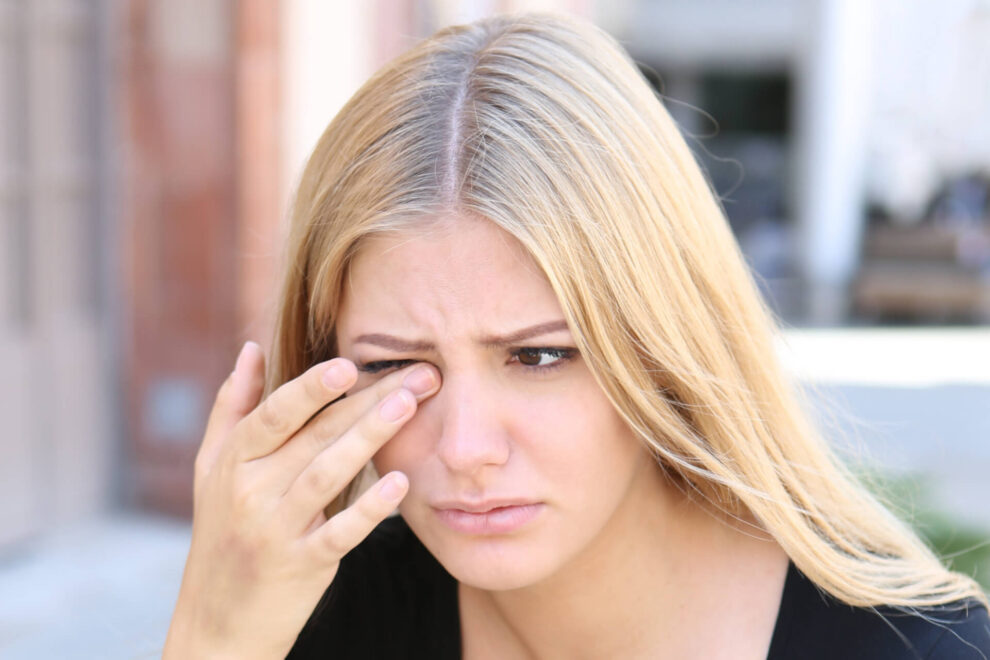Posted by: Kentucky Eye Institute in General Eye Health

Did you know more than 16 million Americans have dry eye syndrome, with twice as many women affected as men?
Dry eye syndrome is a common condition when your tears cannot provide enough lubrication for your eyes. Dry eye leads to a burning, itching, or aching sensation that is very uncomfortable.
Depending on the severity of your dry eye, it can go away on its own, or it may not go away without medical intervention.
Learn more about dry eye syndrome symptoms, causes, and treatment.
What Is Dry Eye Syndrome?
When you blink, a film of tears will spread over your eye to keep the surface smooth and clear. The tear film is made of three layers:
- Oily
- Watery
- Mucus
Each layer serves a unique purpose to keep your eyes moist and clean. When your eyes don’t provide enough tears to protect the surface of your eye, it creates an imbalance.
This imbalance causes your eyes to become itchy, red, watery, and painful. This is dry eye syndrome.
Mild cases can be effectively managed with the right choice of treatment, usually over-the-counter eyedrops or lifestyle changes. However, severe cases may require anti-inflammatory medication or surgery.
Without proper treatment, dry eye syndrome can worsen over time.
What Causes Dry Eyes?
There are many causes and risk factors of dry eye syndrome. These include:
- Gender
- Age
- Environment
- Medication
- Auto-immune disorders
- Hormonal changes
- Vitamin A deficiency
Women are at an increased risk of developing dry eye syndrome due to hormonal fluctuations, including pregnancy and menopause. The same goes for women who take birth control pills and wear contact lenses.
Some women also report dry eyes during their monthly period when estrogen levels fluctuate.
What Are the Symptoms of Dry Eye Syndrome?
The symptoms of dry eye syndrome are mild in most cases. However, dry eyes can lead to more severe symptoms if left untreated. These include:
- Burning sensation
- Itchy eyes
- Aching sensation
- Heavy eyes
- Fatigued eyes
- Sore eyes
- Dryness
- Red eyes
- Blurred vision
- Light sensitivity
- Mucus
- Discomfort when wearing contact lenses
And while it might not make sense, dry eyes can often lead to watery eyes. When eyes dry out, it prompts the lacrimal glands to produce an excess of tears. This eventually overwhelms the eye’s natural drainage system.
If you think you have dry eye syndrome, it’s essential to seek treatment as soon as possible. Left untreated, dry eyes may lead to eye inflammation, a corneal ulcer, or difficulty keeping your eyes open.
How Is Dry Eye Syndrome Diagnosed?
If you are experiencing symptoms of dry eye syndrome, schedule an appointment for an eye exam at your nearest clinic. During your exam, your optometrist will perform a series of tests to evaluate the physical condition of your eyes.
Tests may include:
- Fluorescein eye test
- Shirmer’s test
- Lissamine green test
As part of your exam, your eye specialist will also inspect your eyelids for signs of blocked oil glands. They will also check for inflammation, tear duct blockage, and signs of wear on your corneas.
Dry Eye Syndrome Treatments
After being diagnosed with dry eye syndrome, your optometrist will recommend a treatment plan appropriate to the severity of the condition.
It’s important to note that there is no cure for dry eye, but there are effective ways to manage the condition.
Your optometrist may suggest the following treatment options.
Environmental and Lifestyle Changes
One of the first treatments your optometrist will recommend is lifestyle modifications. This can include:
- Limiting screen time
- Wearing sunglasses while outside
- Taking a break from contact lenses
- Removing makeup before bed
- Placing warm compresses on your eyes
- Adding Omega-3 fatty acids to your diet
Omega-3 has anti-inflammatory properties and may be an effective treatment strategy for improving dry eyes. You can get Omega-3s from fish and other seafood, nuts and seeds, and supplements.
Medication Change
Antidepressants, decongestants, and blood pleasure medications can cause dry eye syndrome. If this is the case, you may need to be prescribed an alternative medication not associated with dry eyes.
If you suspect you have dry eyes, do not stop taking the medication without first speaking with a health care provider.
Lubricants
Eyedrops will replenish the moisture on the outer surface of your eyes. Such eyedrops are generally safe to use as often as you need them, although some suggest no more than four doses per day.
If you need more than four doses per day, you might want to consider alternative treatment.
Switching Contact Lenses
Your current contact lenses may be the driving force behind your dry eyes. The symptoms of dry eyes can be more severe if you wear contact lenses, especially when they start to dry out too.
Switching contact lenses may relieve your dry eyes. If problems persist, you might like to consider vision correction surgery. LASIK can help you achieve between 20/20 and 20/40 vision without the need to wear contact lenses.
Surgery
Severe dry eye disease may need to be treated through surgery. This type of surgery may involve complete or partial closure of tear ducts, keeping the tears on the surface of your eye longer.
Protect Your Eyes
Tears are necessary for protecting your eyes from infections by helping to wash away germs. They also help provide you with a clear vision.
When your eyes don’t produce enough tears, you’re at risk of developing dry eye syndrome. If over-the-counter treatments don’t work, it’s time to see an optometrist.
At Kentucky Eye Institute, we provide exceptional dry eye care services tailored to our patients.
We understand the importance of good eye health. That’s why we aim to serve you with the highest quality of care.
Don’t let dry eyes get you down! Call your nearest office and make an appointment today.
